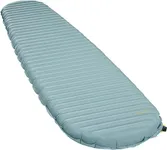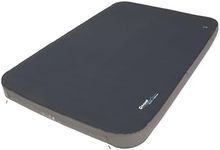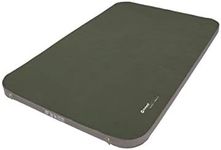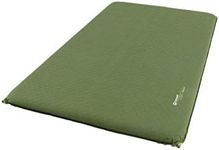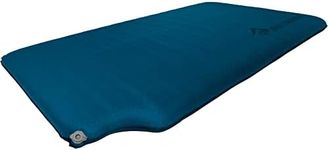Buying Guide for the Best Double Sleeping Pads
Choosing the right double sleeping pad is essential for a comfortable and restful night's sleep while camping or backpacking. A double sleeping pad is designed to accommodate two people, providing insulation and cushioning from the ground. When selecting a double sleeping pad, consider factors such as comfort, insulation, weight, and durability. Understanding the key specifications will help you make an informed decision that best suits your needs and preferences.ComfortComfort is a crucial factor when selecting a double sleeping pad, as it directly impacts the quality of your sleep. Comfort is typically determined by the pad's thickness and the materials used. Thicker pads (around 3-4 inches) generally offer more cushioning and are ideal for car camping or short hikes. Thinner pads (1-2 inches) are lighter and more compact, making them suitable for backpacking. Consider your sleeping preferences and the type of camping you plan to do when choosing the right level of comfort.
Insulation (R-Value)Insulation, measured by the R-value, indicates how well the sleeping pad can keep you warm by preventing heat loss to the ground. A higher R-value means better insulation. For summer camping, an R-value of 1-3 is usually sufficient. For three-season camping, look for an R-value of 3-5. For winter camping, an R-value of 5 or higher is recommended. Choose an R-value based on the lowest temperatures you expect to encounter during your trips.
WeightWeight is an important consideration, especially if you plan to carry the sleeping pad on long hikes or backpacking trips. Lightweight pads (under 3 pounds) are easier to carry and pack, making them ideal for backpacking. Heavier pads (over 3 pounds) may offer more comfort and durability but are better suited for car camping or short hikes. Assess your need for portability versus comfort to determine the appropriate weight for your sleeping pad.
DurabilityDurability refers to the sleeping pad's ability to withstand rough terrain, punctures, and general wear and tear. Durable pads are typically made from thicker, more robust materials like heavy-duty nylon or polyester. If you plan to camp in rugged environments or use the pad frequently, opt for a more durable option. For occasional use or camping in less demanding conditions, a lighter, less durable pad may suffice. Consider how often and where you will use the pad to choose the right level of durability.
Size and DimensionsSize and dimensions are important to ensure that the sleeping pad fits comfortably in your tent and provides enough space for both sleepers. Double sleeping pads come in various sizes, so check the dimensions to ensure it fits your tent and meets your space requirements. Standard double pads are around 72 inches long and 50 inches wide, but larger options are available for more spacious sleeping arrangements. Consider your tent size and personal space preferences when selecting the right dimensions.
Inflation and DeflationInflation and deflation mechanisms affect the ease of setting up and packing away the sleeping pad. Some pads are self-inflating, which means they automatically draw in air when the valve is opened, while others require manual inflation using a pump or by blowing air into them. Self-inflating pads are convenient but may be bulkier, while manually inflated pads can be lighter and more compact. Consider how much effort you are willing to put into setting up and packing away the pad when choosing the inflation method.
PackabilityPackability refers to how easily the sleeping pad can be packed down and transported. A pad that packs down small is easier to fit into a backpack or car trunk. Look for pads that come with a stuff sack or compression straps to make packing easier. If you have limited space or need to carry the pad over long distances, prioritize packability. Consider the available storage space and how you plan to transport the pad when evaluating packability.
